Day 3 - Wednesday 9/14/05

Ministry of the Interior
With jet lag ruling our sleep patterns, an early start was no dilemma. The three of us with 'passport problems' planned to be at the Ministry of the Interior at 7:15am so as to be first in line for the opening at 8am. We were only second in line, but were pleasantly surprised at the presence of a reel of numbered tickets by the door. As the stairwell landing in front of the Office door slowly filled, everyone politely took a number and waited quietly - this was not how I remembered Israel - my memories clearly indicated that Israelis were not good at waiting quietly and queuing up. Well, my memories were justified when the door opened and everyone around us sprang into action, stampeding through the small opening and rushing the counter with the grace and fury of an enraged bison (maybe camel as we were in the Middle East). We managed to get through it all, and in the end emerged successfully with our now valid passports extended for another five years. Huzzah!!
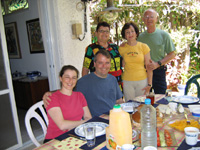
Israeli Breakfast ala Shula
We reported back to headquarters in Rechovot and were treated to a lavish breakfast that included: two kinds of bread and rolls, sliced cucumbers and tomatoes and bell peppers, sliced Hungarian sausage, olives and homemade pickles, homemade jam, 5 types of slicing cheeses and 4 types of cheese spread (Israel is famed for it's many and varied dairy products), burekas (filo dough pockets stuffed with cheese or potato or egg), juices, chocolate croissants, and gourmet coffee courtesy of Itzik and his cappuccino machine. We feasted!! This was a daily occurrence and really a lovely way to start the day as far as we were concerned - we can whole-heartedly recommend 'Dekel's bed and breakfast' as a high-class establishment.
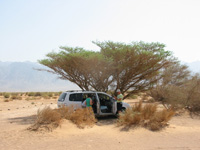
After breakfast, we received delivery of our rental vehicle - a white seven-seater minivan that we named Felix. It had to be rented in John's name in order to get the 'American Tourist' discount. Earlier in the day, we had left John and Itzik alone at the house to deal with car issues while the rest of us dealt with passport issues. Upon our return home, we discovered that Itzik had introduced John to a type of number puzzle called Su-do-ku. Not only did John become obsessed with solving the puzzles themselves, but he also began writing a computer program to solve the puzzles for him.
We piled into Felix and went to our first museum of the trip. Shula explained that our itinerary included three museums, and that she had booked English-speaking guides at each, arranging the itinerary so that we toured them in historical-chronological order (first the Diaspora Museum, then the Holocaust Museum, then the Palmach Museum). To quote my mother: "We went thru history in some incredible museums. Starting with the Diaspora Museum "Beth Hatefutsoth" in Tel Aviv where the flourishing communities all over Europe, Asia, North Africa, etc. were exhibited. Continuing to the Holocaust Museum "Yad Vashem" in Jerusalem where the process of destruction of the European communities was displayed. Ending in the Palmach Museum in Tel Aviv where the struggle of the new state of Israel was exhibited. These three museums are excellent in their exhibits and guidance."
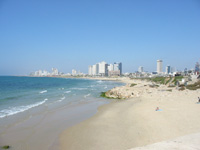
The Diaspora Museum
This morning's destination was Beth Hatefutsoth, the Nahum Goldmann Museum of the Jewish Diaspora, in Tel Aviv. I quote from the brochure: "Beth Hatefutsoth exists to convey the story of the Jewish people from the time of their expulsion from the Land of Israel 2,500 years ago to the present. It relates the unique story of the continuity of the Jewish people through exhibition, education and cultural endeavors, providing multiple avenues of personal historical identification. Our hope is that by sharing the unique story of Jewish endurance, new generations may find the key to their own. When it opened in May 1978, Beth Hatefutsoth was regarded by many museum experts as one of the most innovative museums in the world. It created a whole new concept of what a museum is and has influenced museum culture since". We had a wonderful tour guide just for our group who spoke English with a lovely French accent and truly emphasized the highlights of the museum.
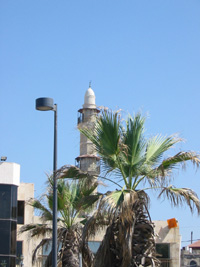
|
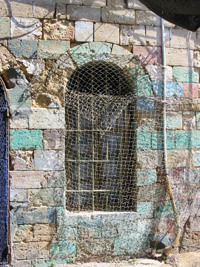
|
Jaffa Flea Market & Old Port
We next drove to Jaffa, an ancient port city, which is now a part of modern Tel Aviv. The natural harbor, defended by protruding rocks, is one of the oldest in the Levant, and the earliest city there was built around 5000 BCE. It was hotly contested and over the years was inhabited by Canaanites, Egyptians, Philistines, Israelites under the rule of Solomon, Assyrians, Babylonians, and the Greeks. After Greek rule crumbled, Jaffa became the port of Judah. It stayed mainly in Jewish control until Mark Anthony gave the city to Cleopatra, and the city once more became Egyptian. After her death the Roman emperor gave Jaffa to Herod. But Herod soon set out to build the harbor of Caesarea, to the detriment of Jaffa. It was destroyed in 68 CE and rebuilt, fought over by the Crusaders and the Arabs, then occupied by the Ottoman Empire. It was destroyed again by Napoleon in 1799, and again during Israel's War of Independence. In 1965 a process of reconstruction began. Artists were encouraged to live in Jaffa and reconstruct their own houses. Modern 'old' Jaffa is the result. Our experience with Jaffa started with the flea market and ended with a tour of the Old Port. We also stopped at the famous Abulafia Bakery for cheese sambusas before driving back to Tel Aviv.
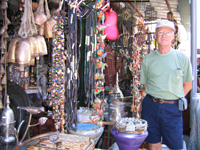
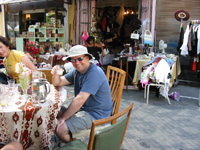
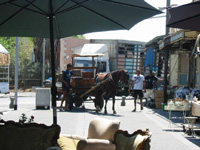
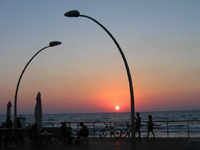
Tel Aviv Promenade
Dinner was at a restaurant on the newly built Tel Aviv Promenade. We dined outdoors and watched the sun set over the Mediterranean.
<<--- Yesterday |
Tomorrow --->> |
| Copyright © 2005 by Oreet Herbst and John Knott |